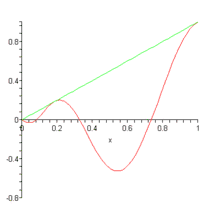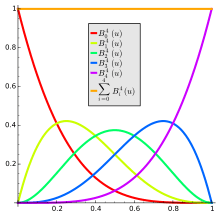Bernstein polynomial
In the mathematical field of numerical analysis, a Bernstein polynomial, named after Sergei Natanovich Bernstein, is a polynomial in the Bernstein form, that is a linear combination of Bernstein basis polynomials.

A numerically stable way to evaluate polynomials in Bernstein form is de Casteljau's algorithm.
Polynomials in Bernstein form were first used by Bernstein in a constructive proof for the Stone–Weierstrass approximation theorem. With the advent of computer graphics, Bernstein polynomials, restricted to the interval [0, 1], became important in the form of Bézier curves.
Definition

The n +1 Bernstein basis polynomials of degree n are defined as
where is a binomial coefficient. So, for example,
The first few Bernstein basis polynomials for blending 1, 2, 3 or 4 values together are:
The Bernstein basis polynomials of degree n form a basis for the vector space Πn of polynomials of degree at most n with real coefficients. A linear combination of Bernstein basis polynomials
is called a Bernstein polynomial or polynomial in Bernstein form of degree n.[1] The coefficients are called Bernstein coefficients or Bézier coefficients.
The first few Bernstein basis polynomials from above in monomial form are:
Properties
The Bernstein basis polynomials have the following properties:
- , if or
- for
- and where is the Kronecker delta function:
- has a root with multiplicity at point (note: if , there is no root at 0).
- has a root with multiplicity at point (note: if , there is no root at 1).
- The derivative can be written as a combination of two polynomials of lower degree:
- The transformation of the Bernstein polynomial to monomials is
- and by the inverse binomial transformation, the reverse transformation is[2]
- The indefinite integral is given by
- The definite integral is constant for a given n:
- If , then has a unique local maximum on the interval at . This maximum takes the value
- The Bernstein basis polynomials of degree form a partition of unity:
- By taking the first derivative of where , it can be shown that
- The second derivative of where can be used to show
- A Bernstein polynomial can always be written as a linear combination of polynomials of higher degree:
- The expansion of the Chebyshev Polynomials of the First Kind into the Bernstein basis is[3]
Approximating continuous functions
Let ƒ be a continuous function on the interval [0, 1]. Consider the Bernstein polynomial
It can be shown that
uniformly on the interval [0, 1].[4]
Bernstein polynomials thus provide one way to prove the Weierstrass approximation theorem that every real-valued continuous function on a real interval [a, b] can be uniformly approximated by polynomial functions over .[5]
A more general statement for a function with continuous kth derivative is
where additionally
is an eigenvalue of Bn; the corresponding eigenfunction is a polynomial of degree k.
Proof
Suppose K is a random variable distributed as the number of successes in n independent Bernoulli trials with probability x of success on each trial; in other words, K has a binomial distribution with parameters n and x. Then we have the expected value and
By the weak law of large numbers of probability theory,
for every δ > 0. Moreover, this relation holds uniformly in x, which can be seen from its proof via Chebyshev's inequality, taking into account that the variance of 1⁄n K, equal to 1⁄n x(1−x), is bounded from above by 1⁄(4n) irrespective of x.
Because ƒ, being continuous on a closed bounded interval, must be uniformly continuous on that interval, one infers a statement of the form
uniformly in x. Taking into account that ƒ is bounded (on the given interval) one gets for the expectation
uniformly in x. To this end one splits the sum for the expectation in two parts. On one part the difference does not exceed ε; this part cannot contribute more than ε. On the other part the difference exceeds ε, but does not exceed 2M, where M is an upper bound for |ƒ(x)|; this part cannot contribute more than 2M times the small probability that the difference exceeds ε.
Finally, one observes that the absolute value of the difference between expectations never exceeds the expectation of the absolute value of the difference, and
See for instance Koralov & Sinai (2007).[6]
Notes
- G. G. Lorentz (1953) Bernstein Polynomials, University of Toronto Press
- Mathar, R. J. (2018). "Orthogonal basis function over the unit circle with the minimax property". Appendix B. arXiv:1802.09518.
- Rababah, Abedallah (2003). "Transformation of Chebyshev-Bernstein Polynomial Basis". Comp. Meth. Appl. Math. 3 (4): 608–622. doi:10.2478/cmam-2003-0038.
- Natanson (1964) p. 6
- Natanson (1964) p. 3
- Koralov, L.; Sinai, Y. (2007). ""Probabilistic proof of the Weierstrass theorem"". Theory of probability and random processes (2nd ed.). Springer. p. 29.
References
- Caglar, Hakan; Akansu, Ali N. (July 1993). "A generalized parametric PR-QMF design technique based on Bernstein polynomial approximation". IEEE Transactions on Signal Processing. 41 (7): 2314–2321. doi:10.1109/78.224242. Zbl 0825.93863.
- Korovkin, P.P. (2001) [1994], "Bernstein polynomials", in Hazewinkel, Michiel (ed.), Encyclopedia of Mathematics, Springer Science+Business Media B.V. / Kluwer Academic Publishers, ISBN 978-1-55608-010-4
- Natanson, I.P. (1964). Constructive function theory. Volume I: Uniform approximation. Translated by Alexis N. Obolensky. New York: Frederick Ungar. MR 0196340. Zbl 0133.31101.
External links
- Kac, Mark (1938). "Une remarque sur les polynomes de M. S. Bernstein". Studia Mathematica. 7: 49–51. doi:10.4064/sm-7-1-49-51.
- Kelisky, Richard Paul; Rivlin, Theodore Joseph (1967). "Iteratives of Bernstein Polynomials". Pacific Journal of Mathematics. 21 (3): 511. doi:10.2140/pjm.1967.21.511.
- Stark, E. L. (1981). "Bernstein Polynome, 1912-1955". In Butzer, P.L. (ed.). ISNM60. pp. 443–461. doi:10.1007/978-3-0348-9-369-5_40. ISBN 978-3-0348-9369-5.
- Petrone, Sonia (1999). "Random Bernstein polynomials". Scand. J. Stat. 26 (3): 373–393. doi:10.1111/1467-9469.00155.
- Oruc, Halil; Phillips, Geoerge M. (1999). "A generalization of the Bernstein Polynomials". Proceedings of the Edinburgh Mathematical Society. 42: 403–413. doi:10.1017/S0013091500020332.
- Joy, Kenneth I. (2000). "Bernstein Polynomials" (PDF). from University of California, Davis. Note the error in the summation limits in the first formula on page 9.
- Idrees Bhatti, M.; Bracken, P. (2007). "Solutions of differential equations in a Bernstein Polynomial basis". J. Comput. Appl. Math. 205: 272–280. doi:10.1016/j.cam.2006.05.002.
- Casselman, Bill (2008). "From Bézier to Bernstein". Feature Column from American Mathematical Society
- Acikgoz, Mehmet; Araci, Serkan (2010). "On the generating function for Bernstein Polynomials". AIP Conf. Proc. 1281: 1141. doi:10.1063/1.3497855.
- Doha, E. H.; Bhrawy, A. H.; Saker, M. A. (2011). "Integrals of Bernstein polynomials: An application for the solution of high even-order differential equations". Appl. Math. Lett. 24: 559–565. doi:10.1016/j.aml.2010.11.013.
- Farouki, Rida T. (2012). "The Bernstein polynomial basis: a centennial retrospective". Comp. Aid. Geom. Des. 29: 379–419. doi:10.1016/j.cagd.2012.03.001.
- Chen, Xiaoyan; Tan, Jieqing; Liu, Zhi; Xie, Jin (2017). "Approximations of functions by a new family of generalized Bernstein operators". J. Math. Ann. Applic. 450: 244–261. doi:10.1016/j.jmaa.2016.12.075.
- Weisstein, Eric W. "Bernstein Polynomial". MathWorld.
- This article incorporates material from properties of Bernstein polynomial on PlanetMath, which is licensed under the Creative Commons Attribution/Share-Alike License.